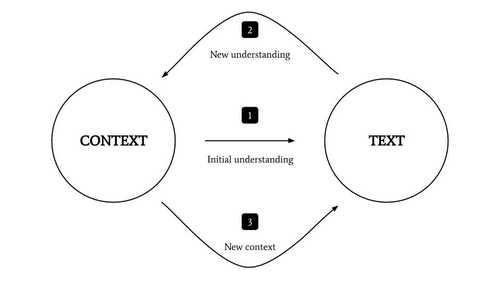The hermeneutic circle: a key to critical reading
Curated from: nesslabs.com
Ideas, facts & insights covering these topics:
5 ideas
·3.21K reads
3
Explore the World's Best Ideas
Join today and uncover 100+ curated journeys from 50+ topics. Unlock access to our mobile app with extensive features.
Understanding a text
We often forget that our interpretation of a text is influenced by our preexisting beliefs, knowledge and expectations.
Hermeneutics theory describes the method and interpretation of a text. The hermeneutic circle encourages us to read in the context of a cultural, historical, and literary context and with our own personal context.
187
1.09K reads
The hermeneutic circle
Interpreting a text doesn't happen out of context. The concept of the hermeneutic circle is to understand the whole by seeing how the parts interact with each other, and how they interact with the whole.
When we first read a text, we gain an initial understanding. As we move through the text, we keep on updating our understanding based on the new knowledge. In turn, the new context will inform the way we interpret the text.
169
585 reads
Consider the context
When practising critical reading, it is crucial to be aware of the context of the text.
Before reading a text, ask :
- What do you want to gain from reading this topic?
- What are your existing beliefs?
- What do you think you know about the topic already?
- What philosophical movement does the author belong to?
- How does this text fit within their main work?
- Take into account the historical and cultural context of the text, the author, and yourself.
It is not practical to go through this process every time you read, but keeping these questions in mind will help you to understand the text.
199
531 reads
Read the text more than once
To allow for the hermeneutic circle to be effective, re-read the text a few times or at least read the parts that are most interesting to you.
Keep on considering the context as you re-read, particularly if the first reading gave you a better understanding of it.
163
446 reads
Interpreting a text is not a linear process
Allow your initial understanding to change. If your first interpretation improved, it's a good sign of critical reading.
The hermeneutic circle will continue to refine your interpretation.
159
559 reads
IDEAS CURATED BY
Spending a large amount of time with someone literally causes you to pick up their habits. Choose your friends wisely.
Holden P.'s ideas are part of this journey:
Learn more about problemsolving with this collection
How to build confidence
How to connect with people on a deeper level
How to create a positive first impression
Related collections
Similar ideas
Read & Learn
20x Faster
without
deepstash
with
deepstash
with
deepstash
Personalized microlearning
—
100+ Learning Journeys
—
Access to 200,000+ ideas
—
Access to the mobile app
—
Unlimited idea saving
—
—
Unlimited history
—
—
Unlimited listening to ideas
—
—
Downloading & offline access
—
—
Supercharge your mind with one idea per day
Enter your email and spend 1 minute every day to learn something new.
I agree to receive email updates

